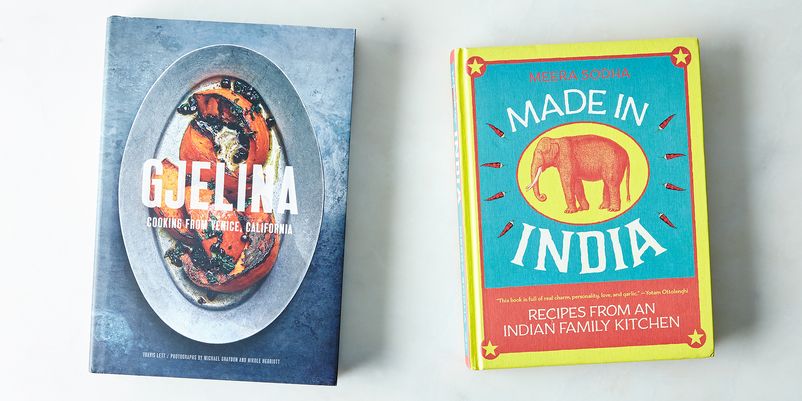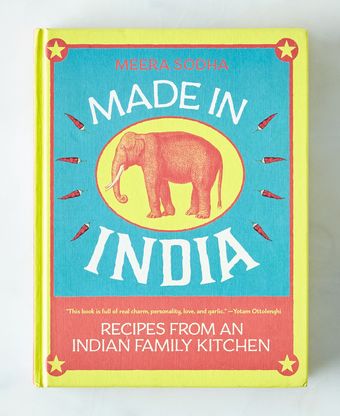I am purely a home cook; I have never worked in a professional kitchen and my technique is basic. I live in New York City, which means ready access to many specialty ingredients, but an apartment kitchen. It’s also affected how I cook: My unofficial rule of thumb has become that I attempt only those things that taste better at home than when made by someone more expert. (For instance, I don’t go in for at-home sushi and I’d rather source croissants than bake them—but those are luxuries allowed the urban dweller.) I read and cooked from these books—Gjelina and Made in India in late fall and early winter, so was somewhat limited in the available choice of produce. Had I been cooking two months earlier, things might have been different.
Or, indeed, living in California! Gjelina’s subtitle is, “cooking from Venice, California” and it’s an unapologetic love-letter to SoCal. The glamorous, spare photographs showcase not just what the book terms the eponymous restaurant’s “grain-and-vegetable-centric, globally inspired cuisine,” but the fact that Gjelina is “the place to be in a city of hot spots, a destination for people of all stripes, from celebrities to food lovers, and the institution that catapulted a sleepy stretch of Abbot Kinney onto the global food scene.”
One is willing to forgive such business because Chef Travis Lett expresses such sincere passion for his ingredients: hip trappings aside, Lett sees his mission as global and important, “a reflection of the changing dialogue about what we eat. People just want to know that someone cares at some point in the process of creating food, that someone is concerned with the big picture.” There is genuine appreciation here for producers and farmers, heritage brands and innovation. Lett also takes the time to thank his team and staff.
This is a book about a restaurant, and one in a specific place: Lett never pretends otherwise. The chapter on “Condiments and Pickles” is enticing, but a despair to those of us who know we can never hope for a walk-in’s arsenal of confits, sauces, pistous, fermented leeks. It’s not that any one recipe is intimidating; but the sheer bounty of it can be. Lett writes that ingredients are “unique expressions of art—more so than anything I could manipulate them into. I am blown away every day by the sheer diversity and quality of the product I have access to in California. The ingredients reveal themselves slowly over time and require sensitivity to fully understand and get the most out of.”
So I felt daunted attempting recipes like Seared Okra, Black Olives, Tomato Confit, Pine Nuts & Chile out of season, or making Grilled Eggplant, Mojo de Ajo & Basil Salsa Verde with the sad, squishy specimens I found at the market. It seemed to fly in the face of Lett's uncompromising Cali ethos—and be besides the point, anyway. However, I did try other recipes with great success, including Roasted Yams with Honey, Espelette & Lime Yogurt; a Roasted Acorn Squash with brown butter and rosemary that’s already joined the repertoire; and a mushroom toast, although I’m going to go ahead and admit I didn’t make my own “buttermilk crème fraiche” for that one. Instructions are clear and concise. I loved a lot of the salad and flavor ideas—smoked trout with grapefruit and avocado; grilled chicories with fried eggs—but be warned that many seemingly simple dishes contain restauranty touches that you may not have handy, like the garlic confit called for in anotherwise pantry-staple roasted cauliflower. It can’t be said enough: This is a restaurant cookbook. Gjelina may focus on straightforward California cuisine, but you may need to adapt slightly for day-to-day. Indeed, what I found myself thinking most often as I read Gjelina was not, “I want to cook that” but “I want to eat there.” (I mean, besides the hot spot thing.)
A cozier enterprise altogether is Meera Sodha’s Made in India. While the title sounds expansive, in fact this jolly-looking book is highly specific and idiosyncratic: Sodha herself was raised in the North of England, and her cuisine is a mixture of Indian, British, and Kenyan influences. As the engaging author writes in her introduction, “An Indian kitchen can be anywhere in the world… Real Indian home cooking is largely an unknown cuisine, and it’s my love for what we Indians really eat at home that has led me to share these recipes with you now.” If Lett gives you a seat at the chef’s table, Sodha holds your hand, stating clearly that her book “is written for everyone, from first-timers to seasoned cooks, and for those who love Indian food but don’t know where to start.”
The short list of recommended equipment contains things like “a good knife, sharp enough to make cutting tomatoes enjoyable and easy.” Substitutions and flexibility are encouraged. The author talks us through Indian ingredients and techniques, suggests sources, gives a tempting array of menus for everyday and special occasions and varying numbers of diners, and discusses wine pairings. A section called “Help” troubleshoots problems like oversalted food or watery sauce.
It must be said: There were a couple of moments when the cutesiness line was approached. The jokey “Eat like an Indian, think like an Indian” section – “spend at least an hour at the door when saying goodbye to people you’re visiting,” “treat cricket as the second religion”—I could have done without.
But I loved everything I cooked, particularly an eggplant and cherry tomato curry (which I did not feel bad making out of season), a roasted butternut squash curry with garlic and tomatoes, and “mum’s chicken curry.” Yes, any menu would have benefited from the arsenal of chutneys and relishes the author provides, but going without (or using a good bottled brand) did not seem to defeat the purpose.
Normally my criterion for whether I want to own a cookbook is four appealing recipes; in the cases of Gjelina and Made in India, both volumes were so dog-eared with turn-downs after one reading that I had to develop a new sub-system of double-folds to indicate VIR status. Both books are glossy and beautiful. Recipes from both worked and inspired. I found myself turning for each as armchair reads and also dinner inspiration. I’d be very happy to be left on a desert island with a copy of either one (well, and a fully-stocked pantry). And both are intensely personal. There are two very specific reasons one book won my round, and here is what they are:
Made in India taught me how to cook perfect rice, every time. I’ve always been one of those rice-phobes, otherwise competent in the kitchen but unable to turn out a batch that wasn’t crunchy or gluey or some horrid mixture of the two. But Sodha’s “Perfect Basmati Rice” was exactly that. And using her “grains of wisdom on cooking the perfect rice” (yes) I have replicated the achievement again and again, making rice constantly and on the slightest pretext. It seems like a small thing, but a book that can demystify a process, lay it out and ensure consistency, has managed a lot.
What really ensured victory, though, was the chapter on ice creams. For years my heart sank when I read the words, “chill according to manufacturer’s instructions.” Like many people, I can only dream of the space for an ice-cream maker. So imagine my disbelieving delight when, after reading an appealing recipe for a cinnamon ice cream, I saw these words: “Churn in an ice cream maker until done…or pop it into a plastic box and then into the freezer, whisking it vigorously after 45 minutes to break up any ice particles. Keep whisking it every 30 minutes for 2 to 3 hours, or until frozen.” It might as well have been an angel’s chorus.



28 Comments
Thanks for the great review!!
Hmm